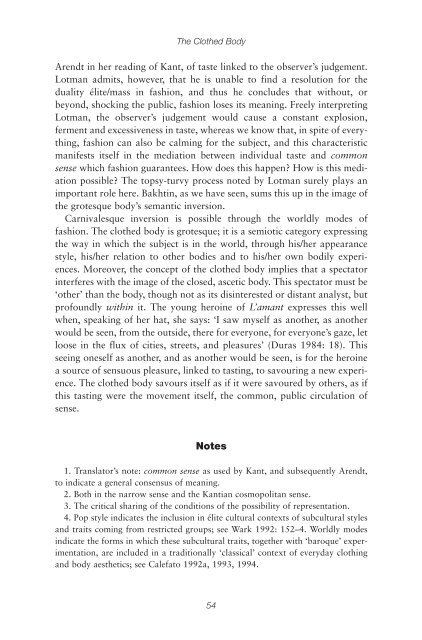You also want an ePaper? Increase the reach of your titles
YUMPU automatically turns print PDFs into web optimized ePapers that Google loves.
<strong>The</strong> <strong>Clothed</strong> <strong>Body</strong><br />
Arendt in her reading of Kant, of taste linked to the observer’s judgement.<br />
Lotman admits, however, that he is unable to find a resolution for the<br />
duality élite/mass in fashion, and thus he concludes that without, or<br />
beyond, shocking the public, fashion loses its meaning. Freely interpreting<br />
Lotman, the observer’s judgement would cause a constant explosion,<br />
ferment and excessiveness in taste, whereas we know that, in spite of everything,<br />
fashion can also be calming for the subject, and this characteristic<br />
manifests itself in the mediation between individual taste and common<br />
sense which fashion guarantees. How does this happen? How is this mediation<br />
possible? <strong>The</strong> topsy-turvy process noted by Lotman surely plays an<br />
important role here. Bakhtin, as we have seen, sums this up in the image of<br />
the grotesque body’s semantic inversion.<br />
Carnivalesque inversion is possible through the worldly modes of<br />
fashion. <strong>The</strong> clothed body is grotesque; it is a semiotic category expressing<br />
the way in which the subject is in the world, through his/her appearance<br />
style, his/her relation to other bodies and to his/her own bodily experiences.<br />
Moreover, the concept of the clothed body implies that a spectator<br />
interferes with the image of the closed, ascetic body. This spectator must be<br />
‘other’ than the body, though not as its disinterested or distant analyst, but<br />
profoundly within it. <strong>The</strong> young heroine of L’amant expresses this well<br />
when, speaking of her hat, she says: ‘I saw myself as another, as another<br />
would be seen, from the outside, there for everyone, for everyone’s gaze, let<br />
loose in the flux of cities, streets, and pleasures’ (Duras 1984: 18). This<br />
seeing oneself as another, and as another would be seen, is for the heroine<br />
a source of sensuous pleasure, linked to tasting, to savouring a new experience.<br />
<strong>The</strong> clothed body savours itself as if it were savoured by others, as if<br />
this tasting were the movement itself, the common, public circulation of<br />
sense.<br />
Notes<br />
1. Translator’s note: common sense as used by Kant, and subsequently Arendt,<br />
to indicate a general consensus of meaning.<br />
2. Both in the narrow sense and the Kantian cosmopolitan sense.<br />
3. <strong>The</strong> critical sharing of the conditions of the possibility of representation.<br />
4. Pop style indicates the inclusion in élite cultural contexts of subcultural styles<br />
and traits coming from restricted groups; see Wark 1992: 152–4. Worldly modes<br />
indicate the forms in which these subcultural traits, together with ‘baroque’ experimentation,<br />
are included in a traditionally ‘classical’ context of everyday clothing<br />
and body aesthetics; see Calefato 1992a, 1993, 1994.<br />
54

















